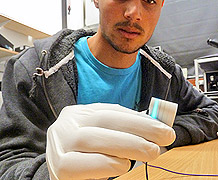
GraphExeter is a material adapted from the ‘wonder material’ graphene.
Exeter researchers have substantially improved the effectiveness of large, flat, flexible lighting via GraphExeter – a material adapted from the ‘wonder material’ graphene. By using GraphExeter, the most transparent, lightweight and flexible material for conducting electricity, instead of pure graphene, the team have increased the brightness of flexible lights by up to almost 50%. The research has also shown GraphExeter makes the lights 30% more efficient than existing examples of flexible lighting, based on state-of-the-art commercial polymers.
The research team believe the breakthrough could help significantly improve the viability of the next generation of flexible screens, which could be used for display screens, smartphones, wearable electronic devices, such as clothing containing computers or MP3 players. Dr Saverio Russo, said: “This exciting development shows there is a bright future for the use of GraphExeter in transforming flexible lighting on a mass scale, and could help revolutionise the electronics industry.
“Not only are lights that utilise GraphExeter much brighter, they are also far more resilient to repeated flexing, which makes ‘bendy’ screens much more feasible for day to day goods such as mobile phones.” Dr Monica Craciun added: “The next step will be to embed these ultra-flexible GraphExeter lights on textile fibres and pioneer ground-breaking applications in health care light therapy.”
The race has been on for scientists and engineers to adapt graphene for flexible electronics. This has been a challenge because of its sheet resistance, graphene dissipates large amounts of energy. In 2012 the teams of Dr Craciun and Profesor Russo, from Exeter’s Centre for Graphene Science, discovered that sandwiched molecules of ferric chloride between 2 graphene layers make a whole new system that is more than a 1000X a better conductor of electricity than graphene and by far the best known transparent material able to conduct electricity. The same team have now discovered that GraphExeter is also more stable than many transparent conductors commonly used by, for example, the display industry. http://www.exeter.ac.uk/news/featurednews/title_524750_en.html







Recent Comments